
- Why Does Water Expand When It Freezes
- Gold Foil Experiment
- Faraday Cage
- Oil Drop Experiment
- Magnetic Monopole
- Why Do Fireflies Light Up
- Types of Blood Cells With Their Structure, and Functions
- The Main Parts of a Plant With Their Functions
- Parts of a Flower With Their Structure and Functions
- Parts of a Leaf With Their Structure and Functions
- Why Does Ice Float on Water
- Why Does Oil Float on Water
- How Do Clouds Form
- What Causes Lightning
- How are Diamonds Made
- Types of Meteorites
- Types of Volcanoes
- Types of Rocks

Sound Energy
Sound energy is a form of kinetic energy caused by the physical vibration of air particles or molecules. The particles collide with other neighboring particles causing them to vibrate. These vibrations travel in a straight line. When they reach our ears, we perceive them as sound.
Sound energy is derived from an external source. Here are some examples of how sound is generated.
- Car honking
- Airplane taking off
- Police whistling
- Dog barking
- Wind howling
- Baby crying
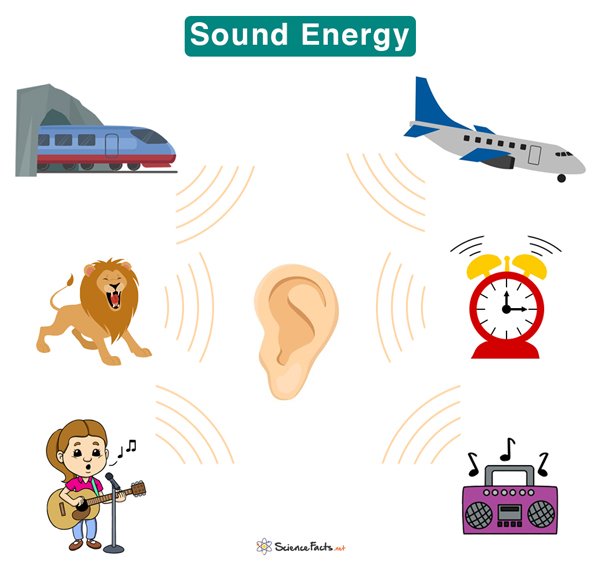
How does Sound Energy Work
The particles vibrate about their position until they reach an equilibrium. The vibrations, and hence sound, are transmitted in the form of a wave, known as a sound wave. The particles vibrate in the same direction as the wave propagates. Such type of wave is known as a longitudinal wave. The sound wave carries energy and keeps traveling until it loses energy.
Sound requires a medium to propagate. It can travel through air, water, wood, glass, or metal. Unlike light, sound cannot propagate in a vacuum since there are no particles to transmit the wave.
How does Sound Wave Transfer Energy to Your Ears
When sound waves reach our ears, they are funneled to the eardrum. The eardrum is a part of the ear that converts sound energy into mechanical movements. It vibrates when struck, and a fluid carries the vibrations through three connected bones. The moving fluid bends a series of hair-like cells that convert the vibrations into nerve impulses. These impulses are carried to the brain by auditory nerves. The brain interprets them as sound.
How is Sound Energy Measured
The intensity of sound is measured in the unit of decibels or dB, named after Scottish-born inventor Alexander Graham Bell. Bell invented the audiometer, a device that measures how well a person can hear sound. The decibel scale is logarithmic, which means that it represents the ratio of two measurable physical quantities. Similarly, sound pressure can also be expressed in dB. For example, a normal speaking voice is 60 dB. The sound of an airplane taking off is 115 dB.
Sound wave frequency is measured in the unit of Hertz or Hz. One Hertz is equal to one sound vibration in one second. For a human to hear the sound, the frequency must be between 20 and 20,000 Hz. Any frequency below 20 Hz is called infrasound; above 20,000 Hz is called ultrasound. These two types of sound are inaudible to the human ear.
Conversion of Sound Energy
From the energy conservation law, energy can neither be created nor destroyed. It can be transferred from one form to another. Here are some examples of how sound energy can be converted into other forms and vice versa.
- A microphone converts sound energy to electrical energy
- A loudspeaker converts electrical energy into sound energy
- A drummer converts mechanical energy into sound energy
- An electric bell converts electrical energy into sound energy
The primary use of sound energy is for hearing. Aside, it has other applications.
- Scientists use infrasonic sound to predict an earthquake, volcano, and avalanche
- A particular type of sound, SONAR (Sound Navigation And Ranging), is used to map the ocean floor
- Doctors use ultrasound to cure tumor cells of a cancer patient without any physical pain
- Doctors also use ultrasound on pregnant women to detect any abnormality in the fetus
- Ultrasound is used in the industry to detect any flaws in machinery parts and to determine the thickness of metal
- Soothing musical sound from Tibetian bowls can remove stress and body pain
- Bats produce ultrasonic waves to communicate among themselves and to find obstacles in their path
- Sound Energy: Everything You Need to Know About This Electrifying Source – Justenergy.com
- Sound Energy – Solarschools.net
- Definition of Sound Energy – Eartheclipse.com
- Sound Energy: A Beginner’s Guide to This Emerging Energy Source – Taraenergy.com
Article was last reviewed on Thursday, July 28, 2022
Related articles

4 responses to “Sound Energy”
May l download it?
Yes, you can cite our article if you decide to refer it.
don’t think they need it anymore
Thanks 😌 for sund je vous remercie de votre réponse.
Leave a Reply Cancel reply
Your email address will not be published. Required fields are marked *
Save my name, email, and website in this browser for the next time I comment.
Popular Articles

Join our Newsletter
Fill your E-mail Address
Related Worksheets
- Privacy Policy
© 2024 ( Science Facts ). All rights reserved. Reproduction in whole or in part without permission is prohibited.
- Random article
- Teaching guide
- Privacy & cookies
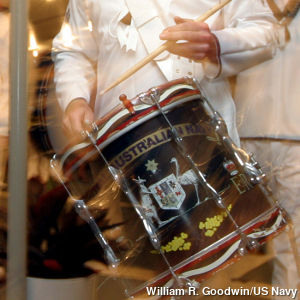
by Chris Woodford . Last updated: July 23, 2023.
Photo: Sound is energy we hear made by things that vibrate. Photo by William R. Goodwin courtesy of US Navy and Wikimedia Commons .
What is sound?
Photo: Sensing with sound: Light doesn't travel well through ocean water: over half the light falling on the sea surface is absorbed within the first meter of water; 100m down and only 1 percent of the surface light remains. That's largely why mighty creatures of the deep rely on sound for communication and navigation. Whales, famously, "talk" to one another across entire ocean basins, while dolphins use sound, like bats, for echolocation. Photo by Bill Thompson courtesy of US Fish and Wildlife Service .
Robert Boyle's classic experiment
Artwork: Robert Boyle's famous experiment with an alarm clock.
How sound travels
Artwork: Sound waves and ocean waves compared. Top: Sound waves are longitudinal waves: the air moves back and forth along the same line as the wave travels, making alternate patterns of compressions and rarefactions. Bottom: Ocean waves are transverse waves: the water moves back and forth at right angles to the line in which the wave travels.
The science of sound waves
Picture: Reflected sound is extremely useful for "seeing" underwater where light doesn't really travel—that's the basic idea behind sonar. Here's a side-scan sonar (reflected sound) image of a World War II boat wrecked on the seabed. Photo courtesy of U.S. National Oceanographic and Atmospheric Administration, US Navy, and Wikimedia Commons .
Whispering galleries and amphitheaters
Photos by Carol M. Highsmith: 1) The Capitol in Washington, DC has a whispering gallery inside its dome. Photo credit: The George F. Landegger Collection of District of Columbia Photographs in Carol M. Highsmith's America, Library of Congress , Prints and Photographs Division. 2) It's easy to hear people talking in the curved memorial amphitheater building at Arlington National Cemetery, Arlington, Virginia. Photo credit: Photographs in the Carol M. Highsmith Archive, Library of Congress , Prints and Photographs Division.
Measuring waves
Understanding amplitude and frequency, why instruments sound different, the speed of sound.
Photo: Breaking through the sound barrier creates a sonic boom. The mist you can see, which is called a condensation cloud, isn't necessarily caused by an aircraft flying supersonic: it can occur at lower speeds too. It happens because moist air condenses due to the shock waves created by the plane. You might expect the plane to compress the air as it slices through. But the shock waves it generates alternately expand and contract the air, producing both compressions and rarefactions. The rarefactions cause very low pressure and it's these that make moisture in the air condense, producing the cloud you see here. Photo by John Gay courtesy of US Navy and Wikimedia Commons .
Why does sound go faster in some things than in others?
Chart: Generally, sound travels faster in solids (right) than in liquids (middle) or gases (left)... but there are exceptions!
How to measure the speed of sound
Sound in practice, if you liked this article..., don't want to read our articles try listening instead, find out more, on this website.
- Electric guitars
- Speech synthesis
- Synthesizers
On other sites
- Explore Sound : A comprehensive educational site from the Acoustical Society of America, with activities for students of all ages.
- Sound Waves : A great collection of interactive science lessons from the University of Salford, which explains what sound waves are and the different ways in which they behave.
Educational books for younger readers
- Sound (Science in a Flash) by Georgia Amson-Bradshaw. Franklin Watts/Hachette, 2020. Simple facts, experiments, and quizzes fill this book; the visually exciting design will appeal to reluctant readers. Also for ages 7–9.
- Sound by Angela Royston. Raintree, 2017. A basic introduction to sound and musical sounds, including simple activities. Ages 7–9.
- Experimenting with Sound Science Projects by Robert Gardner. Enslow Publishers, 2013. A comprehensive 120-page introduction, running through the science of sound in some detail, with plenty of hands-on projects and activities (including welcome coverage of how to run controlled experiments using the scientific method). Ages 9–12.
- Cool Science: Experiments with Sound and Hearing by Chris Woodford. Gareth Stevens Inc, 2010. One of my own books, this is a short introduction to sound through practical activities, for ages 9–12.
- Adventures in Sound with Max Axiom, Super Scientist by Emily Sohn. Capstone, 2007. The original, graphic novel (comic book) format should appeal to reluctant readers. Ages 8–10.
Popular science
- The Sound Book: The Science of the Sonic Wonders of the World by Trevor Cox. W. W. Norton, 2014. An entertaining tour through everyday sound science.
Academic books
- Master Handbook of Acoustics by F. Alton Everest and Ken Pohlmann. McGraw-Hill Education, 2015. A comprehensive reference for undergraduates and sound-design professionals.
- The Science of Sound by Thomas D. Rossing, Paul A. Wheeler, and F. Richard Moore. Pearson, 2013. One of the most popular general undergraduate texts.
Text copyright © Chris Woodford 2009, 2021. All rights reserved. Full copyright notice and terms of use .
Rate this page
Tell your friends, cite this page, more to explore on our website....
- Get the book
- Send feedback

Home » sound energy definition and examples
Sound Energy: Definition And Examples
Daniel Nelson
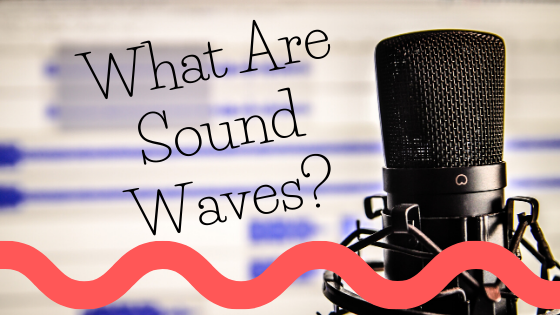
Sound energy is the energy released by the vibration of objects, and measured in a unit called joules. Sound is a wave, and it has oscillating compressions and displacement, being able to store both kinetic energy and potential energy.
That’s the quick definition of sound energy, but to better understand sound energy, it would be helpful to take a closer look at the structure of sound and how it interacts with objects, as well as how it stores and releases energy.
“Sound is the vocabulary of nature.” — Pierre Schaeffer
What Is Sound?
Let’s start off by defining sound. Sound can be thought of as simply the energy that objects create when they are vibrating. As an example, consider a drum that vibrates when hit. The drum pushes the air around the drum around and makes it vibrate in addition. The energy will move through the air, making it vibrate in every direction until the vibrations hit your ear, and this is what causes the perception of sound. While sound can be said to have two different aspects to it – a psychological aspect that is the perception and interpretation of sound within the ears and brain, and the physical process that creates sound energy – this article will deal mainly with the physical aspects of sound.
Sound is the travel of energy through the air and its arrival at the ear following this. You can think of the sound waves as similar to ocean waves, traveling in a specific direction and vibrating in a specific way. However, there is a difference between how ocean waves vibrate and soundwaves vibrate. While ocean waves vibrate up and down, sound waves do not vibrate in this way. Ocean waves are referred to as transverse waves because as the water moves up and down, the energy and the wave transverses forward.
In contrast, as soundwaves travel forward, the air in front of the soundwaves spreads out in some areas and is bunched together in other areas. This creates rarefactions and compressions, stretched out areas and bunched up areas respectively. So while ocean waves vibrant up and down and water, the soundwaves will either pull or push the air back and forth.
Sound Waves And Reflection
If you watch the way that ocean waves interact with a beachfront, you’ll notice that they do things like hit beach walls and are reflected back into the ocean. The waves can also spread up the beach until they run out of energy or spread out in ripples. This is a reflection of the way that energy behaves when transferred by ocean waves, and soundwaves can be thought of as reflecting in this matter as well.
Soundwaves can reflect off surfaces just the way that ocean waves bounce off of the seawall, or much like light reflects off the mirror. Echoes are just reflections of soundwaves, they are simply sound reflections. The sound energy that originates from a source bounces off of the surface and travels back in the direction of the source, entering your ears a second time. There is a delay between the origination of the sound and the echo that you hear, due to the fact that it takes more time for the sound of the echo to reflect off of the surface and travel back.
“Sound waves do not die out. They travel forever and forever. All our sentences are immortal. Our useless bleatings circle the universe for all eternity.” — Fay Weldon
As they travel, sound waves lose their energy . Aspects of the environment, such as wind and weather can affect how quickly the sound waves lose their energy and are overwhelmed by other sounds. This is why it is easier to hear sounds far away on calm days than on windy days, as the wind dissipates their energy quicker. Likewise, ocean waves also would dissipate in similar fashions. Waves of water are capable of traveling far into the ocean, yet they can also be interrupted by stormy weather.
Sound waves are similar to ocean waves and light waves in other aspects well. As ocean waves travel into a bay, they spread out and ripple in circles. Soundwaves have this property as well, which is why they can be heard around corners. For instance, if someone is playing a musical instrument around the corner, the soundwaves will travel out from the source point and spread out as they move, enabling them to be heard even though the soundwaves aren’t coming at you in a straight line. This property is called diffraction.
Measuring Sound Waves
Sounds have different frequencies. Waves on the bottom have higher frequencies than those on top. Photo: LucasVB via Wikimedia Commons, Public Domain
All sound waves have similar properties, acting in the same way. They travel through the environment by making molecules and atoms vibrate back and forth. However, soundwaves are different as well, having different pitches and cadences, being loud or quiet. What accounts for differences between sounds when the soundwaves are operating in the exact same way? The energy that soundwaves make when an object vibrates possesses a specific pattern, small or large. The amplitude or intensity of the sound refers to how loud a sound is, and a larger, more powerful sounds have higher amplitude.
While amplitude is one property of soundwaves, another property of soundwaves is their frequency or pitch . The frequency or pitch of a sound wave refers to the number of waves that a sound source creates in approximately one second. A violin is a higher-pitched instrument than a double bass instrument, so violins make higher-pitched sound/produce more waves second than base instruments.
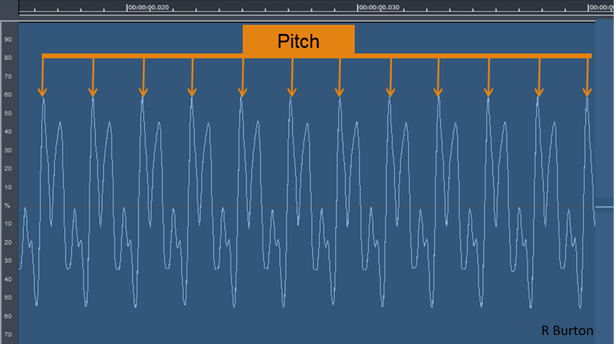
Shows how pitch changes over time. Photo: By Rburtonresearch – Own work, CC BY-SA 4.0, https://commons.wikimedia.org/w/index.php?curid=45074869
So why is it that a piano and violin can produce soundwaves that have the exact same frequency and amplitude and yet sound different from one another? This is because the waves they produce are not identical, even if they are similar in frequency and amplitude. Any given instrument will make many different soundwaves at a given time. There is the main wave that has a certain pitch and amplitude to it, and this main wave is referred to as the fundamental. Over the fundamental, there are waves referred to as overtones and harmonics, which are made out of higher-pitched sounds with a frequency that is many times higher than the fundamental frequency.
Due to these facets of soundwaves, every instrument has its own unique combination of harmonics and frequencies referred to as a timbre. This means that even very similar instruments have their own unique sound profile. The amplitude of the waves produced by a certain instrument also shifts in unique ways over a period of time, higher-pitched noises frequently dissolve quicker and die off than lower tones.
The Speed Of Sound
As previously mentioned, sound carries energy and waves, and therefore the speed of sound refers to the speed at which the sound waves move. The speed of sound is the speed at which sound energy moves between two different points. The speed of sound isn’t actually a constant speed, rather it differs in different atmospheric conditions. Sound will travel at different speeds through gases, liquids, and solids, and even the speed it has through a specific type of material can change. However, in general, the speed of sound at sea level is around 1220 km an hour or 760 miles per hour.
The speed of sound is roughly correlated with the density of the medium it is traveling through, and it travels faster through solid and liquid materials than gas. Sound travels around 15 times faster through a section of steel than it does through the air, and it also travels through the water about four times faster than air. In terms of how sound travels through gases, the speed of sound depends on the type of gas and other factors like temperature. The chemical makeup of the gas influences the speed at which the sound travels, for instance, sound travels around three times quicker in helium gas than in the regular air found in the atmosphere. Sound also travels quicker in the warmer air that is close to the ground than in the colder air which is higher up.
“Since light travels faster than sound, some people appear to be bright until you hear them speak.” — Brian Williams
So what is the sound barrier? When a jet airplane is said to break the sound barrier , it accelerates to a speed that it is able to move faster than the high-intensity sound waves that are coming from its own engines. As the sound waves compress together, they overlap and produce a barrier that rapidly expands as the jet plane passes through them, creating a powerful, loud sonic boom. The fact that the jets are moving faster than the speed of sound is the reason that fighter planes can fly by a second or two before their jet engines are heard.
How Different Musical Instruments Work

Photo: Pexels via Pixabay, CC0
When it comes to music , different musical instruments produce sound in different ways. Instruments like drums, pianos, and xylophones are known as percussive instruments. These percussive instruments operate through striking an object with a hammer or similar tool, making the object vibrate. The drumhead or piano wire vibrates in its own unique way , creating the sound waves that travel through the air.
Meanwhile, wind instruments and brass instruments function by making an air column resonate, causing the air to vibrate back and forth. The valves and holes on the instrument control the intensity of the residence, altering the pitch of the instrument.
Electrical or synthetic instruments operate by creating electrical vibrations. The circuits within the instrument create different waveforms that either mimic the sounds of traditional instruments or create new sounds altogether.
← Previous post
Next post →
Related Posts

Teacher's Toolkit
- Knowledge Bank
- Planet Watch
Sound Energy
Turn up the volume, knowledge bank energy types of energy sound energy.

Shouting is a form of sound energy.
Sound energy
Sound is the movement of energy through a substance – like air or water – and is caused by vibrations . Solids, liquids and gases transmit sound as waves .
Burning Questions
What is sound energy.
Sound energy is the movement of energy through a substance in waves.
How does sound energy travel?
Sound energy travels in the form of waves. Unlike light energy, sound cannot travel through a vacuum, because there are no atoms to transmit the vibration.
Think of it like a Group Wave at a sports stadium.
Each person that continues the wave is like an atom passing on the vibration. No people means the Wave can't keep going – just like no atoms (such as in a vacuum) means sound waves can't keep moving.
Sound can be transmitted by solids, liquids and gases, as these all have atoms to pass on the vibrations.
How is sound energy produced?
Sound energy is produced when a force causes an object or substance to vibrate. The energy is then transferred through the substance in waves, called sound waves.

Sound waves, like group waves, can only travel if something passes the wave on
What are some examples of sound energy?
Here are some examples of how:

Talk or sing

Clap your hands

Stomp your feet
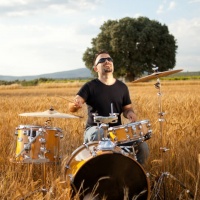
Play a musical instrument
What Do You Mean?
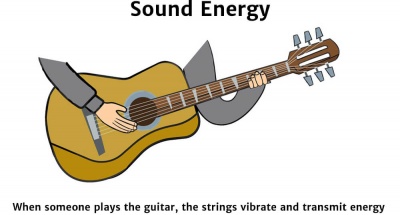
Music is a form of sound energy.
A vacuum is a space that contains absolutely no matter.
Vibrations are what cause sound energy.
Did you know that radio waves aren't actually sound energy? Even though they transmit information about sound, they are actually electromagnetic energy.
Speedy Summary
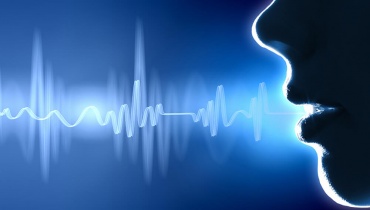
Vocal sound energy is created when expelled air from our lungs passes through the vocal folds.
Sound energy is the movement of energy through a substance – such as air or water – in the form of waves. It is produced when a force causes an object or substance to vibrate.
Take this to the classroom! Curriculum ready content.
Lesson Plans
All Subjects
Sound Energy
In ap physics 2.
Sound energy refers to the form of mechanical wave-like vibrations that travel through matter as longitudinal waves. It is produced by vibrating objects and requires a medium for transmission.
Find Out More ( 1 )
- AP Physics 2 - 2.8 Thermodynamics and Elastic Collisions: Conservation of Momentum
Related terms
Frequency : The number of sound wave cycles that occur in one second, measured in hertz (Hz).
Amplitude : The maximum displacement of particles from their equilibrium position in a sound wave.
Pitch : How high or low a sound is perceived, related to its frequency.
" Sound Energy " also found in:
Subjects ( 3 ).
- College Physics: Mechanics, Sound, Oscillations, and Waves
- Physical Science
© 2024 Fiveable Inc. All rights reserved.
Ap® and sat® are trademarks registered by the college board, which is not affiliated with, and does not endorse this website..
- Skip to primary navigation
- Skip to main content
- Skip to footer
Science Struck
How Does Sound Travel? Here’s the Science Behind This Concept
When sound waves travel through a medium, the particles of the medium vibrate. Vibrations reach the ear and then the brain which senses them and we recognize sound. Read on for an explanation of how sound travels.
Like it? Share it!
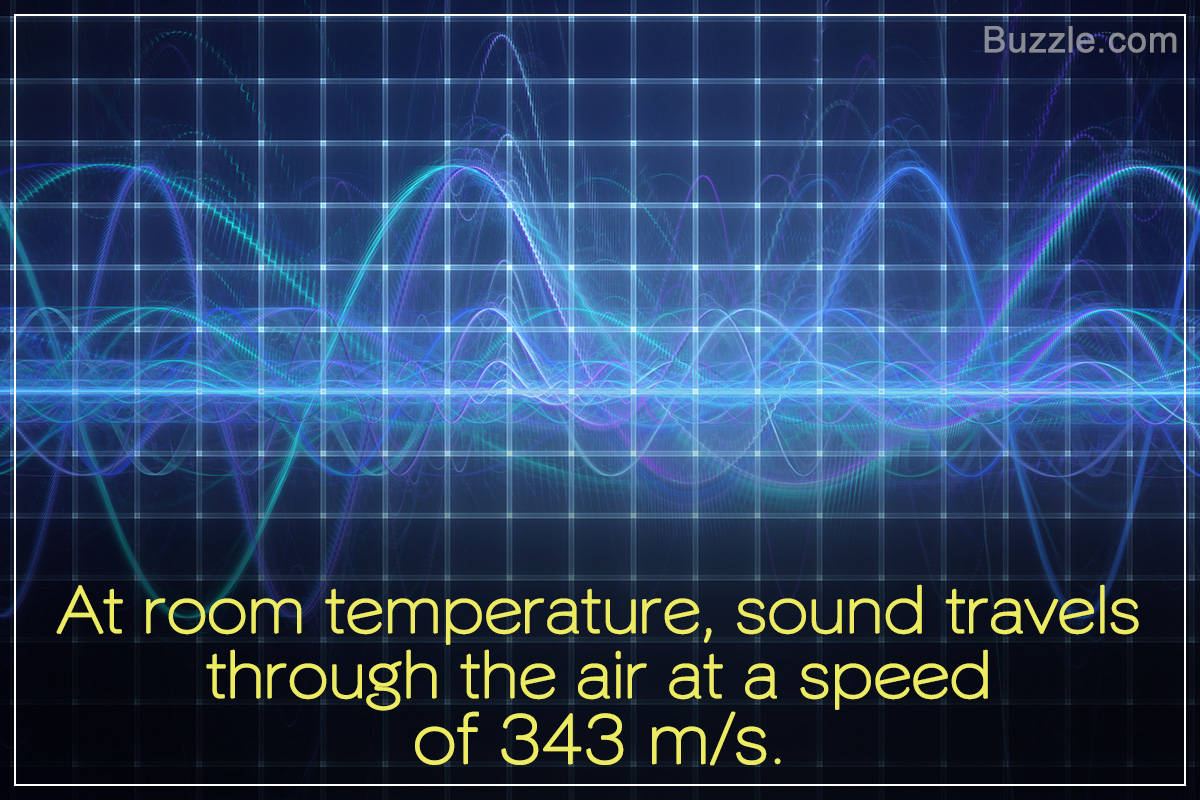
Sound is a series of compression and rarefraction waves that can travel long distances. It is produced by the vibration of the particles present in its medium; a medium is the material through which sound can travel. Presence of a medium is a must for the movement of sound waves. There are various types of medium through which sound waves can move like solids, liquids, gases, plasma, etc. Sound cannot travel through vacuum.
Characteristics of Sound Waves
The speed and the physical characteristics of sound largely varies with the change in its ambient conditions. The speed of sound depends on the density of the medium though which it is traveling. If its density is quite high, then sound would travel at a faster pace. When sound travels through gaseous medium, its speed varies with respect to changes in temperature.
The frequency of sound waves is nothing but the total number of vibrations that have been produced. The length of sound waves vary according to its frequency. Sound waves with long wavelengths have low frequency or low pitch; and those with short wavelengths have high frequency or high pitch. Our ears are capable of hearing only those sound waves which lie in the range between 20 and 20,000 vibrations per second.
How do Sound Waves Travel?
Basically, there are three things that are required for the transmission of sound. They are: a source that can transmit the sound, a medium through which sound can pass (like, water, air, etc.), and the receiver or the detector which receives the sound. The traveling process of sound has been explained below.
Creation of Sound
When a physical object moves in air, it causes vibrations which leads to formation of a series of compression waves in the air. These waves travel in the form of sound. For instance, when we strum the strings of a guitar or hit the head of a drum, the to-and-fro motion of the strings or the drum head creates compression waves of sound in the surrounding air. Similarly, when we speak, our vocal cords vibrate and the sound is created. This type of vibration occurs not just in atmospheric air but in other mediums like, solids and liquids as well. For instance, when a train is moving on a railroad made up of steel, the sound waves thus produced travel via these tracks.
At room temperature, sound travels through air with a speed of 343 m/s, through water at 1,482 m/s, and through steel at 5,960 m/s. As you can see, sound waves travel in a gaseous medium at a slow pace because its molecules are loosely bound and have to cover a long distance to collide with another molecule. In solid medium, the atoms are so closely packed that the vibration is readily transmitted to the neighboring atoms, and sound travels quite fast. In liquid medium, the bonding between the component particles are not as strong as in solids. Therefore, the sound waves move through it at a less speed as compared to solid.
Detection of Sound
When the sound waves hit the receiver, it causes some vibration in that object. The detector captures just a part of the energy from the moving sound wave. This energy of vibration is then converted to electrical signals. Thus, when the sound waves reach our ears, the eardrum present inside it vibrates. This vibration reaches our inner ear and is converted into nerve signals. As a result, we can hear the sound. Devices like microphone can detect sound. The sound waves create vibrations in its membrane which forms electrical signals that gets amplified and recorded.
So, how does sound travel? Vibration of an object causes vibrations of the same frequency in the surrounding medium. The vibrations are sent to the inner ear. After the auditory nerve picks up these vibrations, electrical signals are sent to the brain where the vibrations are recognized as sound.
Get Updates Right to Your Inbox
Privacy overview.
The Nature of Sound
Introduction.
Sound is a longitudinal, mechanical wave.
Sound can travel through any medium, but it cannot travel through a vacuum. There is no sound in outer space.
Sound is a variation in pressure. A region of increased pressure on a sound wave is called a compression (or condensation). A region of decreased pressure on a sound wave is called a rarefaction (or dilation).
The sources of sound
- vibrating solids
- rapid expansion or compression (explosions and implosions)
- Smooth (laminar) air flow around blunt obstacles may result in the formation of vortices (the plural of vortex) that snap off or shed with a characteristic frequency. This process is called vortex shedding and is another means by which sound waves are formed. This is how a whistle or flute produces sound. Also the aeolian harp effect of singing power lines and fluttering venetian blinds.
What are the different characteristics of a wave? What are the things that can be measured about waves? Amplitude, frequency (and period), wavelength, speed, and maybe phase. Deal with each one in that order.
amplitude, intensity, loudness, volume
Amplitude goes with intensity, loudness, or volume. That's the basic idea. The details go in a separate section .
[ISO 226:2003]
- Unlike our ears and hydrophones, fish ears don't detect sound pressure, which is the compression of molecules. Instead, they perceive something called particle motion, the tiny back-and-forth movements of particles in response to sound waves.
speed of sound
The speed of sound depends upon the type of medium and its state. Sound generally travels faster in solids than in liquids than in gases.
The speed of sound in a medium is generally affected by two things: elasticity and inertia. This is the Newton-Laplace equation. Laplace added the γ (gamma) correction factor for ideal gases.
For solids…
For fluids (which incudes liquids and gases)…
For ideal gases…
Hi there. The speed of sound is faster in solids that have some stiffness like steel and slower in those that are softer like rubber.
Basically liquids. Actually, basically water.
The speed of sound in water is somewhat difficult to determine since it is affected by temperature, pressure, density, and salinity (or the amount of any other other dissolved substances). The speed of sound in water can be found using this emprically derived equation …
v = 1449.2 + 4.6 T − 0.055 T 2 + 0.00029 T 3 + (1.34 − 0.010 T )( s − 35) + 0.16 h
Generally, an increase in temperature and salinity will increase the speed of sound in water. Usually, ocean salinity is estimated at around 35 ppt, so the equation above is essentialy a function of temperature and depth.
Acoustic Thermometry of Ocean Climates (ATOC)
- in water, sounds below 1 kHz travel much farther than higher frequencies
- shipping noise is loudest in the 30 to 200 Hz range [lowest piano note to middle of cello]
- blue and fin wales are the loudest sound in the 17 to 30 Hz range
- "In pre-industrial times, the low frequency range of 15 to 300 Hz in which most of the baleen whales sing was the quietest part of the sound spectrum, nestled between the subsonic ramblings of earthquakes and the higher pitched rattle of wind, waves and rain." Bob Holmes. "Noises Off." New Scientist. 1 March 1997: 30–33.
ideal gases
Let's be honest. All we really care about is the speed of sound in air.
- The speed of sound in air is approximately 345 m/s (about 1250 kph, 770 mph, 1100 ft/s).
- The speed of sound in air is nearly the same for all frequencies and amplitudes.
- It increases with temperature.
The speed of sound in air as a function of temperature can be found using these approximate equations…
- the linear one
- the one with the square root in it
Where should this go?
frequency, pitch, tone
The frequency of a sound wave is called it pitch . High frequency sounds are said to be "high pitched" or just "high"; low frequency sounds are said to be "low pitched" or just "low".
human hearing and speech
Humans are generally capable of hearing sounds between 20 Hz and 20 kHz (although I can't hear sounds above 13 kHz). Sounds with frequencies above the range of human hearing are called ultrasound . Sounds with frequencies below the range of human hearing are called infrasound .
- Typical sounds produced by human speech have frequencies on the order of 100 to 1,000 Hz.
- The peak sensitivity of human hearing is around 4,000 Hz.
- Interaural Time Difference (ITD)
- Interaural Phase Difference (IPD) Phase differences are one way we localize sounds. Only effective for wavelengths greater than 2 head diameters (ear-to-ear distances).
- Interaural Level Difference (ILD) Sound waves diffract easily at wavelengths larger than the diameter of the human head (around 500 Hz wavelength equals 69 cm). At higher frequencies the head casts a "shadow". Sounds in one ear will be louder than the other.
- 1,400 different pitches
- (whistle register?)
- modal — the usual speaking register
- vocal fry — the lowest of the three vocal registers
More in the next section.
- avalanches: location, depth, duration
- meteors: altitude, direction, type, size, location
- ocean waves: storms at sea, magnitude, spectra
- severe weather: location, intensity
- tornadoes: detection, location, warning, core radius, funnel shape, precursors
- turbulence: aircraft avoidance, altitude, strength, extent
- earthquakes: precursors, seismic-acoustic coupling
- volcanoes: location, intensity
- Elephants, whales, hippos, rhinoceros, giraffe, okapi, and alligator are just a few examples of animals that create infrasound.
- Some migratory birds are able to hear the infrasonic sounds produced when ocean waves break. This allows them to orient themselves with coastlines.
- An elephant is capable of hearing sound waves well below our the human hearing limitation (approximately 30 Hertz). Typically, an elephant's numerous different rumbles will span between 14 and 35 Hertz. The far reaching use of high pressure infrasound opens the elephant's spatial experience far beyond our limited capabilities.
- Silent Thunder, Katy Payne
- microchiropterans a.k.a. microbats: carnivorous bats ( not fruit bats or flying foxes)
- cetaceans : dolphins, porpoises, orcas, whales
- two bird species: swiftlets and oilbirds
- some visually impaired humans have learned this technique
- echo sounding
- fish finders
- medical ultrasonography (the images generated are called sonograms ).
Sound Energy: Definition, Characteristics, and Measurement Techniques
Sound energy is a form of mechanical energy propagated through mediums such as air, water, or solids, emanating from the vibrations of an object and characterized by attributes like frequency, amplitude, and duration. It manifests in various forms, including audible sound within the frequency range perceivable by the human ear (20 Hz to 20 kHz), infrasound below this range, and ultrasound above it, each finding unique applications from natural disaster monitoring to medical diagnostics. The impact of sound energy on humans and the environment is assessed through key acoustic parameters like the Equivalent Continuous Sound Level (Leq), which represents cumulative exposure over time, and the Sound Exposure Level (SEL), quantifying the energy content of specific events.
Definition of sound energy
Sound energy is the mechanical energy transmitted through a medium (like air, water, or solids) by the vibration of an object, manifesting as sound waves. This form of energy, which can be detected by living beings, is characterized by frequency, amplitude, and duration and encompasses kinetic energy from particle motion and potential energy from medium compression and rarefaction. Energy facilitates communication, entertainment, and various technological applications, demonstrating its vital role in both natural and human-made environments.
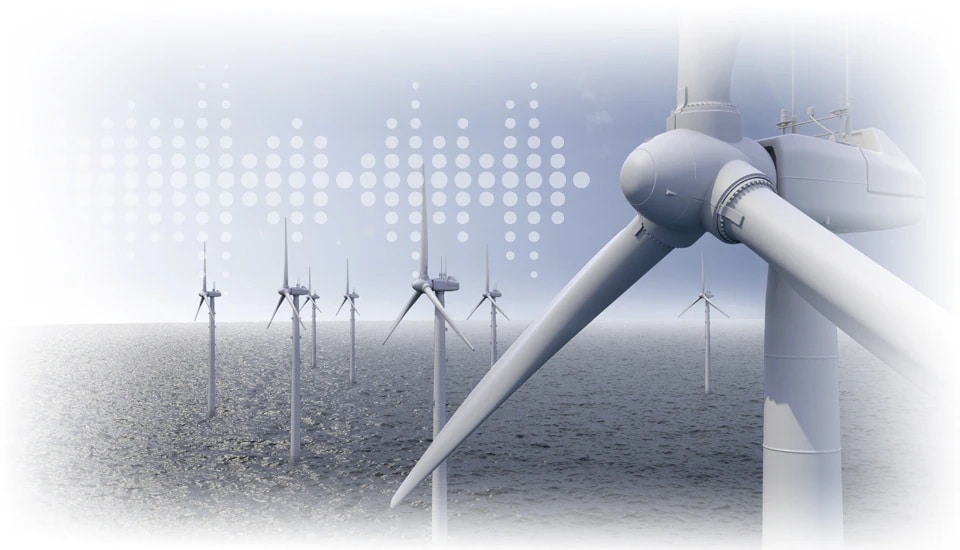
What are the types of sound energy?
Sound energy is categorized into three main types based on frequency: audible sound (20 Hz to 20 kHz), infrasound (below 20 Hz), and ultrasound (above 20 kHz). Each type has unique characteristics and applications. Audible sound forms the basis of human hearing and communication, infrasound is utilized in studying environmental and geological phenomena, and ultrasound has critical applications in healthcare and industrial diagnostics, demonstrating the diverse utility of sound energy.
How do we hear sound energy?
The process of hearing sound energy involves the conversion of sound pressure waves into electrical signals by the ear, which are then interpreted by the brain. When sound waves enter the ear, they cause the eardrum to vibrate, transferring energy to the three small bones in the middle ear (the ossicles). These vibrations are then transmitted to the cochlea in the inner ear, where hair cells convert them into electrical impulses that travel along the auditory nerve to the brain. This remarkable process allows us to perceive the myriad sounds of our environment, from the gentle rustle of leaves to complex musical compositions.

What determines the speed of sound wave?
The speed of sound wave varies depending on the medium through which it travels, being faster in solids, slower in liquids, and slowest in gases. Factors that affect the speed include the medium’s density and its elastic properties. Temperature also plays a significant role, especially in gases, where warmer temperatures increase the speed at which the sound energy travels due to the energy density and movement of the gas molecules. Understanding these factors is crucial in various applications, including acoustical engineering and environmental noise assessment.
At warmer temperatures, the gas molecules have more kinetic energy and move faster. This increased movement and energy density lead to quicker transmission of sound waves through the gas, hence increasing the speed of sound. This principle explains why sound travels faster through warm air than through cold air. For example, on a hot day, sound will travel faster and potentially farther than on a cold day, due to the increased energy density and movement of the air molecules caused by the higher temperature.
What is noise energy?
Noise energy is a subset of sound energy characterized by its unwanted, disruptive nature, potentially leading to adverse effects on human health and environmental tranquility. It arises from both natural and artificial sources and is subjectively perceived based on its context and the listener’s sensitivity. Managing noise energy through strategic planning and technological interventions is essential for maintaining auditory health and societal well-being.

Examples of sound energy produced by various sources
Sound energy originates from a wide array of natural and artificial sources, each contributing uniquely to the acoustic landscape. Natural sources, such as biological sounds and environmental noises, offer essential cues for ecological balance and human interaction with nature. Artificial sources, including machinery, transportation, electronic devices, and musical instruments, reflect human activity’s diverse and significant impact on the sonic environment. Understanding these sources’ characteristics and managing their output is crucial for minimizing noise pollution and enhancing auditory experiences.
What is voice energy?
Voice energy is the specific sound energy produced by the human vocal apparatus during speech or singing. It results from the complex interaction of airflow from the lungs and the vibration of the vocal cords, modulated by the vocal tract to create a rich variety of human vocal sounds. Voice energy’s unique blend of physical production mechanisms and expressive capabilities highlights its importance in communication and artistic expression.

Assessing the impact of sound energy on humans
To evaluate sound energy’s effects on humans, several acoustic parameters are used. The Equivalent Continuous Sound Level (Leq) and the Sound Exposure Level (SEL) are primary metrics for gauging sound exposure, providing a measure of cumulative sound energy over time and the energy content of specific events, respectively. Sound Power and Sound Intensity further quantify the energy emitted by sources and the flow of sound energy, offering insights necessary for noise control and environmental health assessment. These parameters collectively enable a comprehensive analysis of sound energy’s impact, guiding mitigation strategies to protect human well-being and environmental quality.

Can sound energy be converted to electrical energy?
Yes, sound energy can be converted into electrical energy through the use of transducers, such as microphones or piezoelectric devices. These transducers capture the vibrations caused by sound waves and convert them into mechanical wave of a microphone membrane which produces electrical signals. This process is fundamental in technologies like acoustic energy harvesting, where ambient noise is converted into usable electrical power, and in sound level meters, which measure the intensity of sound for various applications, from workplace safety to environmental monitoring.
When sound waves, which are fluctuations in air pressure caused by vibrating objects, encounter a microphone, they interact with the microphone’s diaphragm (a thin, flexible membrane). The movement of the microphone’s diaphragm is then converted into electrical signals. This conversion is typically achieved through various mechanisms depending on the type of microphone. For example, in condenser microphones, the diaphragm acts as one plate of a capacitor, and its vibrations cause changes in the distance between the plates, resulting in variations in capacitance. These variations are then converted into electrical signals by the microphone’s internal electronics.


How to measure parameters related to sound energy with Svantek sound level meters?
Measuring parameters related to sound energy accurately requires sophisticated instruments capable of detailed analysis. Svantek sound level meters, such as the models 971, 977, and 979, are designed for this purpose, offering features like dedicated energy parameters, WAV recording, and spectra analysis. These meters enable the assessment of sound energy in environments, capturing nuances from the lowest infrasound frequencies to the highest ultrasound frequencies. They are invaluable tools in fields such as occupational health and environmental acoustics, providing the data necessary to comply with regulations, mitigate noise pollution, and protect human health.
Key Takeaways
Sound energy is mechanical energy that travels through various media due to the vibration of objects, characterized by measurable properties such as frequency, amplitude, and duration.
It exists in three primary forms: audible sound, infrasound, and ultrasound; each with specific frequency ranges and applications, from communication and entertainment to industrial and medical uses.
The impact of sound energy on humans and the environment is quantified using parameters like Leq (Equivalent Continuous Sound Level) and SEL (Sound Exposure Level), which evaluate cumulative sound exposure and the energy content of noise events, respectively.
Sound energy arises from both natural and artificial sources, with natural sources including biological and environmental sounds, and artificial sources encompassing machinery, transportation, and electronic devices.
Effective management of sound energy, especially noise pollution, is crucial for protecting human health and ensuring environmental quality. This involves strategic planning, technological interventions, and adherence to regulations.
Measurement and Analysis Tools: Advanced sound level meters, such as the Svantek models mentioned, provide sophisticated tools for sound analysis. These instruments feature dedicated energy parameters, WAV recording, and spectra analysis capabilities, essential for detailed acoustic studies, compliance monitoring, and noise mitigation strategy development.
Application and Regulation Compliance: The use of sound level meters in various fields highlights the importance of precise sound measurement in ensuring compliance with noise exposure regulations, enhancing environmental acoustics, and safeguarding occupational health.
Ask for the price offer for Sound Level Meter
Please indicate the subject of your enquiry:
* Country Afghanistan Aland Islands Albania Algeria Andorra Angola Anguilla Antarctica Antigua and Barbuda Argentina Armenia Aruba Australia Austria Azerbaijan Bahamas Bahrain Bangladesh Barbados Belarus Belgium Belize Benin Bermuda Bhutan Bolivia, Plurinational State of Bonaire, Sint Eustatius and Saba Bosnia and Herzegovina Botswana Bouvet Island Brazil British Indian Ocean Territory Brunei Darussalam Bulgaria Burkina Faso Burundi Cambodia Cameroon Canada Cape Verde Cayman Islands Central African Republic Chad Chile China Chinese Taipei Christmas Island Cocos (Keeling) Islands Colombia Comoros Congo Congo, the Democratic Republic of the Cook Islands Costa Rica Cote d'Ivoire Croatia Cuba Curaçao Cyprus Czech Republic Denmark Djibouti Dominica Dominican Republic Ecuador Egypt El Salvador Equatorial Guinea Eritrea Estonia Ethiopia Falkland Islands (Malvinas) Faroe Islands Fiji Finland France French Guiana French Polynesia French Southern Territories Gabon Gambia Georgia Germany Ghana Gibraltar Greece Greenland Grenada Guadeloupe Guatemala Guernsey Guinea Guinea-Bissau Guyana Haiti Heard Island and McDonald Islands Holy See (Vatican City State) Honduras Hungary Iceland India Indonesia Iran, Islamic Republic of Iraq Ireland Isle of Man Israel Italy Jamaica Japan Jersey Jordan Kazakhstan Kenya Kiribati Korea, Democratic People's Republic of Korea, Republic of Kuwait Kyrgyzstan Lao People's Democratic Republic Latvia Lebanon Lesotho Liberia Libyan Arab Jamahiriya Liechtenstein Lithuania Luxembourg Macao Macedonia, the former Yugoslav Republic of Madagascar Malawi Malaysia Maldives Mali Malta Martinique Mauritania Mauritius Mayotte Mexico Moldova, Republic of Monaco Mongolia Montenegro Montserrat Morocco Mozambique Myanmar Namibia Nauru Nepal Netherlands New Caledonia New Zealand Nicaragua Niger Nigeria Niue Norfolk Island Norway Oman Pakistan Palestinian Territory, Occupied Panama Papua New Guinea Paraguay Peru Philippines Pitcairn Poland Portugal Qatar Reunion Romania Russian Federation Rwanda Saint Barthélemy Saint Helena, Ascension and Tristan da Cunha Saint Kitts and Nevis Saint Lucia Saint Martin (French part) Saint Pierre and Miquelon Saint Vincent and the Grenadines Samoa San Marino Sao Tome and Principe Saudi Arabia Senegal Serbia Seychelles Sierra Leone Singapore Sint Maarten (Dutch part) Slovakia Slovenia Solomon Islands Somalia South Africa South Georgia and the South Sandwich Islands South Sudan Spain Sri Lanka Sudan Suriname Svalbard and Jan Mayen Swaziland Sweden Switzerland Syrian Arab Republic Tajikistan Tanzania, United Republic of Thailand Timor-Leste Togo Tokelau Tonga Trinidad and Tobago Tunisia Turkey Turkmenistan Turks and Caicos Islands Tuvalu Uganda Ukraine United Arab Emirates United Kingdom United States Uruguay Uzbekistan Vanuatu Venezuela, Bolivarian Republic of Viet Nam Virgin Islands, British Wallis and Futuna Western Sahara Yemen Zambia Zimbabwe
—Proszę wybrać opcję—
Consent to contact via email Read more...
I hereby consent to the processing of my personal data, i.e. my full name and e-mail address, by SVANTEK SP. Z O.O. with its registered office in Warsaw at ul. Strzygłowska 81 for the purpose of receiving marketing information on the products and services offered by SVANTEK SP. Z O.O. via electronic means of communication, in particular via e-mail, in accordance with the provisions of Article 10 sec. 1 and 2 of the Act on providing services by electronic means.
Consent to contact via phone Read more...
I hereby consent to the processing of my personal data, i.e. my full name and phone number, by SVANTEK SP. Z O.O. with its registered office in Warsaw at ul. Strzygłowska 81 for the purpose of marketing activities with the use of telecommunications terminal equipment and automatic calling machines within the meaning of the Telecommunications Act.
Consent to receiving newsletter Read more...
I hereby consent to receiving from SVANTEK SP. Z O.O. with its registered office in Warsaw at ul. Strzygłowska 81, via electronic means to the e-mail address I have provided, the newsletter and marketing information on the products and services offered by SVANTEK SP. Z O.O., within the meaning of the Act on providing services by electronic means.
* Consent to contact by authorised Svantek Distributor Read more...
I declare that I have been informed that my data may be transferred to entities that process personal data on behalf of the Administrator, in particular to distributors - such entities process data on the basis of an agreement with the Administrator and exclusively in accordance with its instructions. In such cases, the Administrator requires third parties to maintain the confidentiality and security of information and verifies that they provide appropriate measures to protect personal data.
Some of the entities processing personal data on behalf of the Administrator are established outside the EEA. In connection with the transfer of your data outside the EEA, the Administrator verifies that these entities provide guarantees of a high level of personal data protection. These guarantees stem in particular from the obligation to apply the standard contractual clauses adopted by the Commission (EU). You have the right to request a copy of the standard contractual clauses by sending a request to the Controller.
I declare that I have been informed on my right to withdraw my consent to the processing of my personal data at any time, to access the provided personal data, to rectify, erase, restrict processing and object to the processing of my data, as well as the right to lodge a complaint with the President of the of the Personal Data Protection Office in the event of an infringement of the provisions of GDPR.

An authorized SVANTEK consultant will help You with the details such as the required accessories for your noise & vibration monitoring task.
NOTIFICATIONS
Sound on the move.
- + Create new collection
Sound is a pressure wave, but this wave behaves slightly differently through air as compared to water. Water is denser than air, so it takes more energy to generate a wave, but once a wave has started, it will travel faster than it would do in air.
A relay race
Sound travels by particles bumping into each other as they vibrate. It is a little like a relay race – each runner holds a little bit of information (the baton), and when they make contact with the next runner, they pass the information on.
In the case of sound, the runners are particles and the information (baton) they are passing along is energy of vibration. In a sound wave, a particle picks up some energy and keeps it until it bumps into a neighbouring particle. The next particle will then pick up the energy and transfer it to the next one in the chain. This happens extremely fast and is detected as a wave of pressure.
Sound won’t travel in a vacuum because there are no particles to bump together to transmit the vibration.
Sound in air
In a gas like air, the particles are generally far apart so they travel further before they bump into one another. There is not much resistance to movement so it doesn’t take much to start a wave, but it won’t travel as fast.
Sound in water
In water, the particles are much closer together, and they can quickly transmit vibration energy from one particle to the next. This means that the sound wave travels over four times faster than it would in air, but it takes a lot of energy to start the vibration. A faint sound in air wouldn’t be transmitted in water as the wave wouldn’t have enough energy to force the water particles to move.
Sound in solids
In a solid, the particles are even closer together and linked by chemical bonds so the wave travels even faster than it does in either liquid or air, but you need quite a lot of energy to start the wave at the beginning.
Sound and temperature
Temperature has a marked influence on the speed of sound. This is not due to a change in how closely together the particles are to each other but relates to the amount of energy that each particle has. Hot particles have more energy and transmit sound better than cold particles. Water in Antarctica will transmit sound slower than water in the tropics.
Some comparisons for the speed of sound in different materials
Related content.
Explore the science concept related to sound further with these articles:
- Hearing sound – the basics of sound waves
- Measuring sound – the different parts of a sound wave, how we talk about and measure sound
- Sound – visualising sound waves – helps students to 'see’ sound waves with videos and diagrams
In our recorded PLD session Sounds of Aotearoa a group of primary science educators introduce some fun ways you can learn and teach about sound.
Activity ideas
Use these activities to explore some essential physics ideas relating to sound, but in a whole new way.
- Modelling waves with slinkies – stay indoors and model how sound travels.
- Catching worms using ground sounds – go outdoors and investigate whether there is any evidence that earthworms respond to vibrations in the ground.
- Sound detectives – can you locate sounds while blindfolded?
- Make and use a hydrophone – and listen to underwater sounds.
- Sound on an oscilloscope – use oscilloscope software and your computer to make and watch a visual sound display.
- Investigating sound – simple exploratory activities and questions to experience and build an understanding of sound.
- Hearing sounds – using whispers and vibrations to hear and experience how sound moves.
- Hearing sounds under water – go underwater yourselves to listen to sounds
- Measuring the speed of sound – use a timing app to measure the speed of sound.
See our newsletters here .
Would you like to take a short survey?
This survey will open in a new tab and you can fill it out after your visit to the site.
- svg]:fill-accent-900">
How do sound waves work?
By Brian S. Hawkins
Updated on Jun 1, 2023 2:00 PM EDT
8 minute read
We live our entire lives surrounded by them. They slam into us constantly at more than 700 miles per hour, sometimes hurting, sometimes soothing . They have the power to communicate ideas, evoke fond memories, start fights, entertain an audience, scare the heck out of us, or help us fall in love. They can trigger a range of emotions and they even cause physical damage. This reads like something out of science fiction , but what we’re talking about is very much real and already part of our day-to-day lives. They’re sound waves. So, what are sound waves and how do they work?
If you’re not in the industry of audio, you probably don’t think too much about the mechanics of sound. Sure, most people care about how sounds make them feel, but they aren’t as concerned with how the sound actually affects them. Understanding how sound works does have a number of practical applications , however, and you don’t have to be a physicist or engineer to explore this fascinating subject. Here’s a primer on the science of sound to help get you started.
What’s in a wave
When energy moves through a substance such as water or air, it makes a wave. There are two kinds of waves: longitudinal ones and transverse ones. Transverse waves, as NASA notes , are probably what most people think of when they picture waves—like the up-down ripples of a battle rope used to work out. Longitudinal waves are also known as compression waves, and that’s what sound waves are. There’s no perpendicular motion to these, rather, the wave moves in the same direction as the disturbance.
How sound waves work
Sound waves are a type of energy that’s released when an object vibrates. Those acoustic waves travel from their source through air or another medium, and when they come into contact with our eardrums, our brains translate the pressure waves into words, music, or signals we can understand. These pulses help you place where things are in your environment.
We can experience sound waves in ways that are more physical, not just physiological, too. If sound waves reach a microphone —whether it’s a plug-n-play USB livestream mic or a studio-quality microphone for vocals —it transforms them into electronic impulses that are turned back into sound by vibrating speakers . Whether listening at home or at a concert, we can feel the deep bass in our chest. Opera singers can use them to shatter glass. It’s even possible to see sound waves sent through a medium like sand, which leaves behind a kind of sonic footprint.
That shape is rolling peaks and valleys, the signature of a sine (aka sinusoid) wave. If the wave travels faster, those peaks and valleys form closer together. If it moves slower, they spread out. It’s not a poor analogy to think of them somewhat like waves in the ocean. It’s this movement that allows sound waves to do so many other things.
It’s all about frequency
When we talk about a sound wave’s speed, we’re referring to how fast these longitudinal waves move from peak to trough and back to peak. Up … and then down … and then up … and then down. The technical term is frequency , but many of us know it as pitch. We measure sound frequency in hertz (Hz), which represents cycles-per-second, with faster frequencies creating higher-pitched sounds. For instance, the A note right above Middle C on a piano is measured at 440 Hz—it travels up and down at 440 cycles per second. Middle C itself is 261.63 Hz—a lower pitch, vibrating at a slower frequency.
Understanding frequencies can be useful in many ways. You can precisely tune an instrument by analyzing the frequencies of its strings. Recording engineers use their understanding of frequency ranges to dial in equalization settings that help sculpt the sound of the music they’re mixing . Car designers work with frequencies—and materials that can block them—to help make engines quieter. And active noise cancellation uses artificial intelligence and algorithms to measure external frequencies and generate inverse waves to cancel environmental rumble and hum, allowing top-tier ANC headphones and earphones to isolate the wearer from the noise around them. The average frequency range of human hearing is 20 to 20,000 Hz.
What’s in a name?
The hertz measurement is named for the German physicist Heinrich Rudolf Hertz , who proved the existence of electromagnetic waves.
Getting amped
Amplitude equates to sound’s volume or intensity. Using our ocean analogy—because, hey, it works—amplitude describes the height of the waves.
We measure amplitude in decibels (dB). The dB scale is logarithmic, which means there’s a fixed ratio between measurement units. And what does that mean? Let’s say you have a dial on your guitar amp with evenly spaced steps on it numbered one through five. If the knob is following a logarithmic scale, the volume won’t increase evenly as you turn the dial from marker to marker. If the ratio is 4, let’s say, then turning the dial from the first to the second marker increases the sound by 4 dB. But going from the second to the third marker increases it by 16 dB. Turn the dial again and your amp becomes 64 dB louder. Turn it once more, and you’ll blast out a blistering 256 dB—more than loud enough to rupture your eardrums. But if you’re somehow still standing, you can turn that knob one more time to increase your volume to a brain-walloping 1,024 decibels. That’s almost 10 times louder than any rock concert you’ll ever encounter, and it will definitely get you kicked out of your rehearsal space. All of which is why real amps aren’t designed that way.
Twice as nice
We interpret a 10 dB increase in amplitude as a doubling of volume.
Parts of a sound wave
Timbre and envelope are two characteristics of sound waves that help determine why, say, two instruments can play the same chords but sound nothing alike.
Timbre is determined by the unique harmonics formed by the combination of notes in a chord. The A in an A chord is only its fundamental note—you also have overtones and undertones. The way these sound together helps keep a piano from sounding like a guitar, or an angry grizzly bear from sounding like a rumbling tractor engine.
[Related: Even plants pick up on good vibes ]
But we also rely on envelopes, which determine how a sound’s amplitude changes over time. A cello’s note might swell slowly to its maximum volume, then hold for a bit before gently fading out again. On the other hand, a slamming door delivers a quick, sharp, loud sound that cuts off almost instantly. Envelopes comprise four parts: Attack, Decay, Sustain, and Release. In fact, they’re more formally known as ADSR Envelopes.
- Attack: This is how quickly the sound achieves its maximum volume. A barking dog has a very short attack; a rising orchestra has a slower one.
- Decay: This describes how fast the sound settles into its sustained volume. When a guitar player plucks a string, the note starts off loudly but quickly settles into something quieter before fading out completely. The time it takes to hit that sustained volume is decay.
- Sustain: Sustain isn’t a measure of time; it’s a measure of amplitude, or volume. It’s how loud the plucked guitar note is after the initial attack but before it fades out.
- Release: This is the time it takes for the note to drift off to silence.
Speed of sound
Science fiction movies like it when spaceships explode with giant, rumbling, surround-sound booms . However, sound needs to travel through a medium so, despite Hollywood saying otherwise, you’d never hear an explosion in the vacuum of space.
Sound’s velocity , or the speed it travels at , differs depending on the density (and even temperature) of the medium it’s moving through—it’s faster in the air than water, for instance. Generally, sound moves at 1,127 feet per second, or 767.54 miles per hour. When jets break the sound barrier , they’re traveling faster than that. And knowing these numbers lets you estimate the distance of a lightning strike by counting the time between the flash and thunder’s boom—if you count to 10, it’s approximately 11,270 feet away, or about a quarter-mile. (Very roughly, of course.)
A stimulating experience
Anyone can benefit from understanding the fundamentals of sound and what sound waves are. Musicians and content creators with home recording set-ups and studio monitors obviously need a working knowledge of frequencies and amplitude. If you host a podcast, you’ll want as many tools as possible to ensure your voice sounds clear and rich, and this can include understanding the frequencies of your voice, what microphones are best suited to them , and how to set up your room to reflect or dampen the sounds you do or do not want. Having some foundational information is also useful when doing home-improvement projects— when treating a recording workstation , for instance, or just soundproofing a new enclosed deck. And who knows, maybe one day you’ll want to shatter glass. Having a better understanding of the physics of sound opens up wonderful new ways to explore and experience the world around us. Now, go out there and make some noise!
This post has been updated. It was originally published on July 27, 2021.
Latest in Science
Move over, atomic clocks: nuclear clocks are on the way move over, atomic clocks: nuclear clocks are on the way.
By Andrew Paul
Astronomers really like the South Pole, but why? Astronomers really like the South Pole, but why?
By Briley Lewis
What is sound energy definition and examples?
Sound energy is the physical vibration waves that travel through the air to reach the ears signaling the brain to interpret incoming sound(s). Sound energy derives from an external source like playing a drum, for example, triggering vibrations to carry through the ambient air to engage listeners.
Table of Contents
What is a sound simple definition?
1 : a particular auditory impression heart sounds heard by auscultation. 2 : the sensation perceived by the sense of hearing. 3 : mechanical radiant energy that is transmitted by longitudinal pressure waves in a material medium (as air) and is the objective cause of hearing.
What is the definition of sound energy for kids?
Sound is energy that we can hear. It is a type of kinetic energy that is made from the vibration of matter. Sound moves from the source of its vibration through other matter, like air or water. Depending on how the sound moves or the type of vibrations that made it, sound can be loud or soft, high or low, or distorted.
What are 3 facts about sound energy?
Fact 1: There are many different types of energy. Of all these types, sound energy produces the lowest amount of energy. Fact 2: Since sound energy produces just a limited amount of energy, it cannot be used to generate electricity. Fact 3: Sound waves lose energy as they move through a medium.
What are 5 examples of sound energy?
- an air conditioning fan.
- an airplane taking off.
- a ballerina dancing in toe shoes.
- a balloon popping.
- the bell dinging on a microwave.
- a boombox blaring.
- a broom swishing.
- a buzzing bee.
Who discovered sound energy?
The origin of the science of acoustics is generally attributed to the Greek philosopher Pythagoras (6th century bc), whose experiments on the properties of vibrating strings that produce pleasing musical intervals were of such merit that they led to a tuning system that bears his name.
What is the SI unit of sound?
Since this energy can be measured, the most common SI unit of sound that is used is Decibel which is abbreviated as dB. This unit is basically used to express the ratio of some value of a physical property to another, mainly on a logarithmic scale. This is called as Decibel Scale or DB Scale.
Are sound waves energy?
Solids, liquids, and gases all transmit sound as energy waves. Sound energy is the result when a force, either sound or pressure, makes an object or substance vibrate. That energy moves through the substance in waves. Those sound waves are called kinetic mechanical energy .
What are the 3 types of sound?
Sound waves fall into three categories: longitudinal waves, mechanical waves, and pressure waves.
What has sound energy?

What is sound energy in basic science?
Sound energy is the form of energy that is audible for humans. It’s created when an object vibrates resulting in sound waves that have the frequency between 16 Hz and 20 Hz. These vibrations travel through the air until they reach our ears.
How do we hear sound energy?
Sound waves enter the outer ear and travel through a narrow passageway called the ear canal, which leads to the eardrum. The eardrum vibrates from the incoming sound waves and sends these vibrations to three tiny bones in the middle ear. These bones are called the malleus, incus, and stapes.
Why is sound energy important?
Without sound we wouldn’t hear and therefore wouldn’t speak. Of course animals can’t speak (human talk), but they can still communicate just as effectively. By grunting, crying, screeching etc they can communicate across vast distances, conveying important messages that may be critical to their wellbeing and survival.
What are the examples of sound?
- Snapping fingers.
What is a sentence for sound energy?
Sound-energy Sentence Examples Here, the doctor inserts a probe into the ear which emits a tone with a certain amount of sound energy. Most of the sound energy was front soundstage with good audio panning on occasion across the front channels.
What are the 2 uses of sound energy?
- Communication.
- Observation.
- Information.
- Entertainment.
- Notification.
What are 5 facts about sound energy?
- Sound cannot travel through space since there are no molecules to travel through.
- Do you know what is louder than a car horn?
- The loudest natural sound on earth is caused by an erupting volcano.
- Dogs are capable of hearing sounds at a much higher frequency than humans can.
How is sound created?
Sound is created by a vibrating object. For example, when a drum is struck, the flexible skin (sometimes called a membrane) of the drum vibrates. The compression and expansion of the air on either side of the vibrating membrane produces differences in air pressure.
Who heard sound first?
The first organisms to be able to hear things were probably the bony fishes, which appeared on this planet about 400 million years ago.
Is sound energy renewable?
Sound energy is associated with the vibrations of matter (sound waves vibrate air particles – that’s how you can hear), so is a form of kinetic energy (the energy all things have when they move). It is not an energy source, so it doesn’t make sense to call it “non-renewable” or “renewable”.
What is the formula of sound?
If the temperature is TC = 20 °C (T = 293 K), the speed of sound is v = 343 m/s. The equation for the speed of sound in air v = √γRTM can be simplified to give the equation for the speed of sound in air as a function of absolute temperature: v=√γRTM=√γRTM(273K273K)=√(273K)γRM√T273K≈331m/s√T273K. v=fλ.
What is the range of sound?
A normal human ear is able to hear sounds with frequencies from 20 Hz to 20,000 Hz. The range of 20 Hz to 20,000 Hz is called the audible frequency range. The sounds we hear comprise of various frequencies.
What is the volume of sound called?
Another important and easily measured factor is sound intensity , or volume. We measure sound intensity (also referred to as sound power or sound pressure) in units called decibels. Decibels (dB) are named in honor of Alexander Graham Bell, the inventor of both the telephone and the audiometer.
Which type of wave is sound?
Longitudinal waves A longitudinal wave is one where all the particles of the medium (such as gas, liquid or solid) vibrate in the same direction as the wave. Sound waves are longitudinal waves. When longitudinal waves travel through any given medium, they also include compressions and rarefactions.
What is the sound of waves called?
The literary word is usually ‘susurration’. This derives from the Latin verb ‘susurrare’, meaning to whisper, so is strictly appropriate only for gentle waves. Larger waves are sometimes said to thunder.
Craving More Content?
Read our latest blog posts
What forces act on a box sliding down a ramp.
These can be divided into two components, the normal (resisting) force pushing into the slope which produces friction and the shear or driving force pushing the…
What’s the difference between Applied Physics and engineering?
Engineering is an almost entirely applied science. However, the difference between applied physics and engineering and is that engineers are much more concerned with how a…
How can I improve my physics?
Keep studying. You need to keep studying by yourself every day. Engage fully in class. Without any participation in class, you will not be able to…

- Visit Our Blog about Russia to know more about Russian sights, history
- Check out our Russian cities and regions guides
- Follow us on Twitter and Facebook to better understand Russia
- Info about getting Russian visa , the main airports , how to rent an apartment
- Our Expert answers your questions about Russia, some tips about sending flowers

Russian regions
- Altay republic
- Irkutsk oblast
- Kemerovo oblast
- Khakassia republic
- Krasnoyarsk krai
- Novosibirsk oblast
- Omsk oblast
- Tomsk oblast
- Tuva republic
- Map of Russia
- All cities and regions
- Blog about Russia
- News from Russia
- How to get a visa
- Flights to Russia
- Russian hotels
- Renting apartments
- Russian currency
- FIFA World Cup 2018
- Submit an article
- Flowers to Russia
- Ask our Expert
Omsk city, Russia
The capital city of Omsk oblast .
Omsk - Overview
Omsk is one of the largest cities in Russia, a major scientific, cultural, sports, transport, and industrial center. The administrative center of Omsk Oblast, it is the second most populous city in Siberia.
The population of Omsk is about 1,126,000 (2022), the area - 567 sq. km.
The phone code - +7 3812, the postal codes - 644000-644246.
Omsk city flag
Omsk city coat of arms.

Omsk city map, Russia
Omsk city latest news and posts from our blog:.
10 November, 2019 / Tomsk - the view from above .
3 July, 2016 / Omsk - the view from above .
20 October, 2012 / The bear at the gate .
2 August, 2012 / Omsk city from bird's eye view .
14 December, 2011 / Time-lapse video of Omsk city .
More posts..
History of Omsk
Foundation of omsk.
The need to build a Russian fortress on the banks of the Irtysh at the mouth of the Om River arose in connection with the steppe nomadic peoples. In particular, with the Oirats, whose tribes in the first decades of the 17th century began to appear within the borders of the Russian state being under the onslaught of their external enemies and as a result of internal civil strife. However, various foreign and domestic political problems of Russia hindered the development and defense of the South Siberian borders.
The situation changed only at the beginning of the 18th century, when the Russian conquest of Siberia intensified. Since Peter I paid great attention to geographical research in the south, the expeditions of that time combined socio-political tasks and tasks of scientific research.
One of such expeditions was led by the Russian military and statesman, associate of Peter I, Major General Ivan Bukhgolts. The goals of the expedition, numbering about 3,000 people, were to search for ore and gold deposits, the discovery of trade routes to India and China, as well as the construction of towns on the Irtysh River.
The expedition left Tobolsk to the south along the Irtysh in July 1715. In the spring of 1716, after a conflict with the Dzungars in the north of today’s Kazakhstan, the remnants of the expedition (about 700 people) withdrew to the mouth of the Om River, where they laid a new fortress named Omsky ostrog (fortified settlement).
According to the census of 1725, 992 people lived in the fortress, in 1742 - 1,092 people. From the first years of its existence, it served as a place of exile for prisoners. After serving hard labor and imprisonment, a lot of them stayed in Omsk for permanent residence.
More Historical Facts…
Omsk in the second half of the 18th century
The ethnic composition of the region’s population was formed in the process of settling the territory. Russians, Germans, Ukrainians, Poles, Belarusians, and representatives of many other nationalities were sent here to serve or were exiled. The indigenous people of the region were the Siberian Tatars and Kazakhs, who switched to a sedentary lifestyle.
The foundation of the second Omsk fortress took place in 1762. The first fortress, although it occupied a favorable geographical position, was wooden and, by the middle of the 18th century, it was dilapidated. In 1765, new stone fortifications were constructed. The first stone structure of the fortress was the Resurrection Military Cathedral, built in 1773 and preserved to this day.
In the end of the 18th century, the Omsk fortress was one of the largest structures in the eastern part of the Russian Empire, its area was more than 30 hectares. In 1782, it was transformed into a town named Omsk within the Tobolsk Governorate. In 1785, the coat of arms of Omsk was approved.
Omsk became the center of management of the Siberian transport routes and the Siberian Cossack army, which not only guarded the South Siberian borders, but also made a huge contribution to the economic development of the steppe expanses of Kazakhstan, the annexation of Central Asia to the Russian Empire.
Omsk in the 19th century
The fire of 1819 destroyed almost half of the town including the archive and the magistrate of Omsk with all the first archival documents. Therefore information about the life of Omsk in the 18th - early 19th centuries is scarce and fragmentary. In 1825, the population of the town was about 9,000 people.
In 1829, the town’s development plan was approved. It was made by the famous Petersburg architect V.I. Geste, who took the city of St. Petersburg as a model with its wide avenues, huge neighborhoods, fountains, cast-iron bridges, and an abundance of green spaces.
The composition of the population of Omsk was not quite usual. In the middle of the 19th century, since Omsk was the center of the military and civil administration, the proportion of the military in the local population reached about 60%.
Fyodor Dostoevsky (one of the greatest psychological novelists in world literature), who served a term of hard labor in the Omsk prison in 1850-1854, in a letter to his brother gave Omsk the following description: “Omsk is a disgusting town. There are almost no trees. In summer, heat and wind with sand, in winter, a snowstorm. I have not seen nature. The town is dirty, military and highly depraved.”
By the second half of the 19th century, Omsk in its development outstripped many steppe towns and became not only an administrative, but also a commercial and industrial center. In 1861, in Omsk, there were 2,122 houses (31 stone houses), 34 factories and plants, about 20 thousand residents.
In 1892, the construction of the Trans-Siberian Railway began, which gave a new impetus to the economy of Siberian towns and positively influenced Omsk. The development of the Trans-Siberian Railway caused an increase in the urban population due to migrants who came to work from the central part of the Russian Empire. According to the 1897 census, 37.3 thousand people lived in Omsk. The town had 14 streets with a total length of more than 140 km and 13 squares.
Omsk in the first half of the 20th century
The beginning of the 20th century was a time of great changes for Siberia. Mass peasant colonization caused a sharp leap in the development of the region’s economy, primarily its agrarian sector, and the Trans-Siberian Railway ensured the inclusion of the local economy in the system of the All-Russian and European markets.
Due to its favorable economic and geographical position - at the intersection of the railway and the Irtysh River, in the middle of a vast agricultural territory - Omsk quickly turned into a large transport, trade and industrial center of Western Siberia and Governor-Generalship of the Steppes (Eastern and Central Kazakhstan).
Wholesale trade in bread, butter and other agricultural products was concentrated here. Omsk also became one of the industrial, social and cultural centers of Western Siberia. By 1903, the city’s population grew to 60 thousand people. In 1914, it had about 134.8 thousand residents. Omsk became the most populous city in Siberia.
During the Civil War on the territory of the former Russian Empire, from June 1918 to November 1919, Omsk was the residence of the Supreme Ruler of Russia, Admiral Alexander Kolchak, who declared this city the capital of white Russia opposing red Russia of the Bolsheviks. Soviet power was finally established in the city in 1920.
In the summer of 1921, an event took place that had a decisive impact on the cultural and economic life of Omsk. The functions of the administrative center of Siberia were transferred from it to the city of Novonikolaevsk (future Novosibirsk). In 1934, Omsk became the administrative center of a separate Omsk Oblast.
Over the years of industrialization, Omsk became one of the largest centers for agricultural engineering in the USSR. The metal-working industry also developed at a rapid pace. In 1939, Omsk numbered more than 288 thousand people.
During the Second World War, about 200 industrial enterprises were evacuated to Omsk, as well as 60 hospitals, dozens of educational institutions, theaters, museums, and hundreds of thousands of refugees.
Omsk after the Second World War
In the post-war years, new enterprises were put into operation in Omsk, all existing factories and plants were reconstructed and expanded. The industrial potential of the city was also strengthened by the Omsk oil refinery, the largest in the country. In connection with the rapid development of industry, especially petrochemical enterprises, the ecological situation deteriorated. The concentration of harmful substances in the air sharply increased. In 1964, the population of Omsk was about 702 thousand people.
In the 1970s-1980s, Omsk developed rapidly. In 1975, the city’s population exceeded 1 million. The most pressing problem was the ecological situation. Omsk was in the top 10 cities of Russia in terms of environmental pollution. Another problem that required an immediate solution was the development of passenger transport. The capacity of Omsk streets was exhausted, and therefore the construction of the subway became an urgent issue.
The economic crisis that gripped Russia after the collapse of the USSR had a negative impact on the economy of Omsk and the region as a whole. There was a significant decline in industrial production, construction volumes fell, and unemployment rose. A lot of organizations of the defense complex, research institutes, and design bureaus found themselves in a deep crisis without the state defense order.
The share of mechanical engineering and metalworking, light industry, and, to a lesser extent, chemical and petrochemical, forestry and woodworking industries decreased. At the same time, the share of the fuel industry, energy, and construction materials industry began to grow.
In the 2000s, Omsk again became one of the most important economic centers of Western Siberia with a developing mechanical engineering, petrochemical industry, various branches of the woodworking, construction industry, and a highly productive agro-industrial complex. In recent years, Omsk has also acquired the features of one of the largest Siberian centers of entrepreneurship and banking/financial activities.
Architecture of Omsk
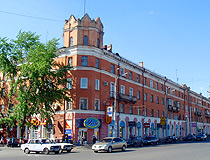
On the street in Omsk
Author: Tim Brown
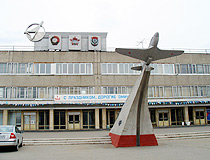
Yak-9 fighter aircraft in front of the aerospace engineering company Polyot in Omsk
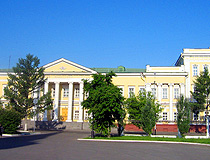
The Omsk Cadet Corps
Author: Stanislav Katsko
Omsk - Features
Omsk is located in the south of the West Siberian Plain at the confluence of the Om River into the Irtysh, about 150 km from the border of Russia with Kazakhstan. About 60% of all residents of Omsk Oblast live in Omsk. The City Day of Omsk is celebrated on the first Saturday of August.
The city’s coat of arms is very similar to the first coat of arms of Omsk approved by Empress Catherine II in 1785. It depicts a part of the brick fortifications, which symbolizes the reason for its foundation as a fortress and the center of the Siberian defensive line.
Omsk belongs to the temperate climatic zone with a continental climate of the forest-steppe of the West Siberian belt. It is distinguished by an abundance of sunlight. The average air temperature in January is minus 16.3 degrees Celsius, in July - plus 19.6 degrees Celsius. The highest wind speeds are observed in winter and spring, which is the reason for frequent snow and dust storms.
In the past, the ecological situation in Omsk was very unfavorable. Since 2011, the city’s environmental development rating has increased significantly. This was the result of large-scale modernization of many large industries (including the Omsk oil refinery). Today, road transport is the main source of air pollution in the city.
The level of pollution of the Omsk rivers - Irtysh and Om - remains consistently high. Swimming in them is prohibited. While industrial effluents are becoming more environmentally friendly, sewers are releasing waste products including diesel fuel and petroleum products into the rivers. Dust raised by dust storms is also a serious problem for the city as it contains a lot of harmful substances including lead.
The city’s industry is based on oil refining, petrochemistry, chemical industry, mechanical engineering (production of aerospace equipment, armored vehicles, agricultural equipment). Omsk is a major transport junction - the Trans-Siberian Railway runs through the city from west to east, and the navigable Irtysh River crosses it from south to north. Omsk Airport offers regular flights to Moscow, St. Petersburg, Novosibirsk, Tyumen, Surgut, Yekaterinburg, Krasnoyarsk, Salekhard, Kazan, Krasnodar, Sochi.
The unfinished subway of Omsk has become famous in Russia thanks to its only one fully built station. Its construction began back in 1992. However, due to funding problems, the completion of the first line was postponed numerous times. In 2019, it was finally decided to permanently stop construction. For local residents, because of the long wait for the completion of the construction, the Omsk metro symbolizes unrealizable hopes, they talk about it with irony.
In Omsk, there are practically no buildings higher than 50 meters, according to this parameter it is one of the lowest cities with a population of over one million. 130 architectural monuments are concentrated in the central part of the city, almost half of the total number.
Main Attractions of Omsk
Dormition Cathedral - the largest church in Omsk located in the very center of the city. The original church was built in 1891-1898. In 1935, it was completely destroyed. In 2005-2007, an exact copy of the building was restored in its original place. This is one of the most beautiful buildings in Omsk. At night, the building is illuminated and looks especially majestic. Tarskaya Street, 7.
Irtysh Embankment - the main walking street of Omsk with a picturesque view of the Irtysh River. Built in the middle of the 20th century, the embankment was reconstructed in the 2000s. You can walk along the alley on foot, ride rollerblades or a bike.
Merchant Batyushkin’s Mansion (1902). This architectural monument is located on the Irtysh Embankment. It is also known as the Kolchak’s House because Alexander Kolchak, the Supreme Ruler of Russia, lived in this building in 1919. One part of the building is occupied by the registry office of the Central District of Omsk. The Center for the Study of the History of the Russian Civil War is also open here. Irtyshskaya Naberezhnaya Street, 9.
Omsk State Museum of History and Local Lore - one of the oldest museums in Siberia and Russia founded in 1878. In total, this museum has over 200 thousand various objects of cultural, historical and artistic value. The museum is especially proud of such exhibits as the cast-iron figures of the Chinese lions Shi-Tzu, presented to the museum from China in 1895, as well as the skeleton of a woolly mammoth almost 3 meters high. Lenina Street, 23?.
Omsk Regional Museum of Fine Arts named after M.A. Vrubel - one of the largest museums of fine arts in Siberia. It has collections of foreign and Russian art from antiquity to the present day. In total, there are over 22 thousand works by painters, graphic artists and sculptors, as well as more than 1.5 thousand rare folios.
Walking through the exhibition halls, you can admire the canvases of Shishkin, Aivazovsky, Surikov, Repin, Serov, Vereshchagin. The exhibition of rare icons dating from the 17th-20th centuries is of constant interest among visitors, as well as a unique collection of jewelry made of precious metals found in the Scythian and Sarmatian burial mounds. Two buildings of the museum are located at Lenina Street 3 and 23.
In November 2019, a new exhibition was opened in a historical building at Muzeynaya Street, 4 - the exhibition of art of the 20th-21st centuries. The Hermitage-Siberia Center is located here too - the first representation of The State Hermitage Museum (the second-largest art museum in the world) beyond the Urals.
Chokana Valikhanova Street - a pedestrian street located in the historic part of Omsk. The street is decorated with abstract architectural forms, flower beds, wrought-iron lanterns. The walking area ends with an observation deck with a picturesque view of the Irtysh River.
Museum of Kondraty Belov . The museum of this landscape painter born in Omsk can be found in a picturesque wooden house, which is considered one of the most interesting architectural monuments of Omsk. The exposition tells about the life and work of Kondraty Belov, as well as about the history of the building itself.
In total, this museum has about 700 exhibits. The permanent exhibition also includes works by Kondraty Belov’s son Stanislav and paintings by some other local artists. In addition, temporary exhibitions of contemporary Omsk artists are regularly held here. Chokana Valikhanova Street, 10.
Plumber Stepanych Monument - an unusual sculpture located in the center of Omsk, which you can literally stumble upon while walking along Lenin Street between the houses #12 and #14. Leaning out of the hatch, the plumber is depicted as realistic and life-size as possible. It is among the most photographed monuments in Omsk. There is a similar sculpture in Bratislava, the capital of Slovakia.
Lyuba Monument . This sculpture, located on the opposite side of Lenin Street from the monument to the plumber Stepanych, is especially loved by Omsk residents and tourists, who love to be photographed against its background.
This beauty in a lace dress with a neckline and a crinoline sitting on an openwork bench and reading a novel had a real prototype - Lyubov (diminutively Lyuba or Lyubasha) Gasford, the wife of the Governor-General of Siberia, who lived in Omsk in the 19th century and died at a young age due to illness. One of the streets of Omsk and the park are named in her memory. She is a local symbol of femininity and beauty.
Omsk Fire Tower - a picturesque architectural monument built at the beginning of the 20th century. Inside the tower there are museum expositions dedicated to the local fire brigade and the history of tower construction. Internatsionalnaya Street, 41?.
Park of Culture and Rest named after the 30th anniversary of the Komsomol - a popular place for walks, recreation and entertainment of Omsk residents and tourists, which has retained “the spirit of the Soviet era” in its name. Today, on an area of 73 hectares, several zones have been organized, various types of recreation are presented. There are walking alleys, ponds, water activities, for example, riding on hydro-scooters.
The ice town is open in winter, the Return of the Dinosaurs exhibition - in summer. The “House Upside Down” exposition is also popular with tourists. This park is a place for mass festivities, city celebrations and events. Maslenitsa, Christmas, City Day, and other holidays are celebrated here. Maslennikova Street, 136.
Natural Park “Bird Harbor” - a specially protected area located on the path of bird migration in the central part of Omsk. During autumn flights, up to 3 thousand birds stop here for rest. It is a great place to enjoy nature, walk along the eco-trail, and observe the life of birds. The park is situated in the floodplain on the left bank of the Irtysh River next to the Victory Park on Yeniseyskaya Street.
Omsk city of Russia photos
Pictures of omsk.
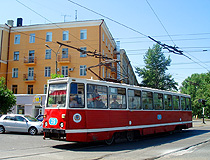
Bogdan Khmelnitsky Monument in Omsk

Lenin Monument in Omsk
Churches of Omsk

Chapel of St. George in Omsk

Cathedral of the Exaltation of the Holy Cross in Omsk

Cathedral of the Nativity in Omsk
Sights of Omsk
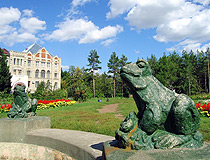
Fountain with frogs in the park next to the main building of the Agricultural Academy in Omsk
Author: Alexey Pavlov
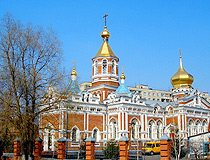
Church of St. Nicholas in Omsk
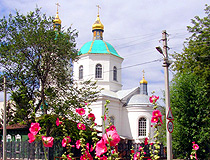
Exaltation of the Holy Cross Cathedral in Omsk
Author: Stanislav Vosinsky
The questions of our visitors
- Currently 2.95/5
Rating: 2.9 /5 (214 votes cast)

IMAGES
VIDEO
COMMENTS
Sound energy is a form of kinetic energy caused by the physical vibration of air particles or molecules. The particles collide with other neighboring particles causing them to vibrate. These vibrations travel in a straight line. When they reach our ears, we perceive them as sound. Examples
There is one crucially important difference between waves bumping over the sea and the sound waves that reach our ears. Sea waves travel as up-and-down vibrations: the water moves up and down (without really moving anywhere) as the energy in the wave travels forward. Waves like this are called transverse waves.
Sound energy is produced when an object vibrates. The sound vibrations cause waves of pressure that travel through a medium, such as air, water, wood or meta...
Sound energy is the form of energy generated when an object vibrates. Once produced through vibrations, sound energy is transferred in waves through mediums such as air and water before it reaches your ears. ... There must be a medium through which sound travels, such as water, air, glass, or metal because it cannot travel through a vacuum. ...
Sound - visualising sound waves. Sound is a form of energy that is caused by the vibration of matter. Sound is transmitted through waves, which travel through solids, liquids and gases. We are most used to the sound travelling through air, but sound is able to travel faster and further in solids and liquids.
The sound energy that originates from a source bounces off of the surface and travels back in the direction of the source, entering your ears a second time. There is a delay between the origination of the sound and the echo that you hear, due to the fact that it takes more time for the sound of the echo to reflect off of the surface and travel ...
Sound energy. In physics, sound energy is a form of energy that can be heard by living things. Only those waves that have a frequency of 16 Hz to 20 kHz are audible to humans. However, this range is an average and will slightly change from individual to individual. Sound waves that have frequencies below 16 Hz are called infrasonic and those ...
Waves as energy transfer. 'Wave' is a common term for a number of different ways in which energy is transferred: In electromagnetic waves, energy is transferred through vibrations of electric and magnetic fields. In sound waves, energy is transferred through vibration of air particles or particles of a solid through which the sound travels ...
Sound energy travels in the form of waves. Unlike light energy, sound cannot travel through a vacuum, because there are no atoms to transmit the vibration. Think of it like a Group Wave at a sports stadium. Each person that continues the wave is like an atom passing on the vibration. No people means the Wave can't keep going - just like no ...
Sound energy refers to the form of mechanical wave-like vibrations that travel through matter as longitudinal waves. It is produced by vibrating objects and requires a medium for transmission. Related terms. Frequency: The number of sound wave cycles that occur in one second, ...
Share it! When sound waves travel through a medium, the particles of the medium vibrate. Vibrations reach the ear and then the brain which senses them and we recognize sound. Read on for an explanation of how sound travels. Sound is a series of compression and rarefraction waves that can travel long distances. It is produced by the vibration of ...
Sound is a longitudinal, mechanical wave. Sound can travel through any medium, but it cannot travel through a vacuum. There is no sound in outer space. Sound is a variation in pressure. A region of increased pressure on a sound wave is called a compression (or condensation). A region of decreased pressure on a sound wave is called a rarefaction ...
The speed of sound wave varies depending on the medium through which it travels, being faster in solids, slower in liquids, and slowest in gases. Factors that affect the speed include the medium's density and its elastic properties. Temperature also plays a significant role, especially in gases, where warmer temperatures increase the speed at which the sound energy travels due to the energy ...
Sound on the move. Sound is a pressure wave, but this wave behaves slightly differently through air as compared to water. Water is denser than air, so it takes more energy to generate a wave, but once a wave has started, it will travel faster than it would do in air.
Propagation of Sound: How Does Sound Travel? We explore Sound Waves and learn about transmission of Sound. Sound needs a medium to travel. Sound can travel i...
Sound waves are a type of energy that's released when an object vibrates. Those acoustic waves travel from their source through air or another medium, and when they come into contact with our ...
Sound energy is the physical vibration waves that travel through the air to reach the ears signaling the brain to interpret incoming sound(s). Sound energy derives from an external source like playing a drum, for example, triggering vibrations to carry through the ambient air to engage listeners.
This means that sound travels faster through water than through air, and faster through bone than through water. When molecules in a medium vibrate, they can move back and forth or up and down. Sound energy causes the molecules to move back and forth in the same direction that the sound is travelling. This is known as a longitudinal wave.
Regardless, sound energy travels and depending on the sound source and the intensity, sound can sometimes be considered a pollutant. So what is sound energy, exactly? Sound energy is turning sound into electricity. Though the science of turning sound energy into electricity is still emerging, it has been done. For example, microphones and ...
Sytnaya Ploshhad, Omsk: See 7 unbiased reviews of Sytnaya Ploshhad, rated 4 of 5 on Tripadvisor and ranked #224 of 1,076 restaurants in Omsk.
The administrative center of Omsk Oblast, it is the second most populous city in Siberia. The population of Omsk is about 1,126,000 (2022), the area - 567 sq. km. The phone code - +7 3812, the postal codes - 644000-644246. Local time in Omsk city is September 1, 7:00 am (+6 UTC).
Okunevo ( Russian: Окунево) is a rural locality (a village) in the Muromtsevsky District of Omsk Oblast, Russia, situated on the Tara River 240 kilometres north of Omsk. [1] Okunevo is one of a number of modern "places of power", or holy places of Russian new religious movements. [1] The majority of the inhabitants of the village are ...
Tripadvisor gives a Travelers' Choice award to accommodations, attractions and restaurants that consistently earn great reviews from travelers and are ranked within the top 10% of properties on Tripadvisor.